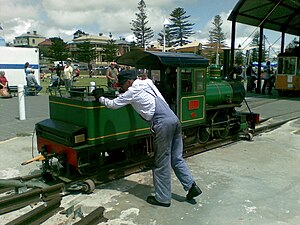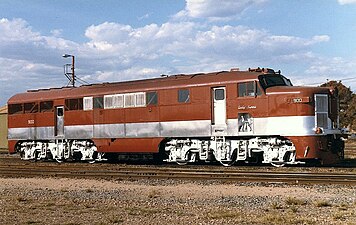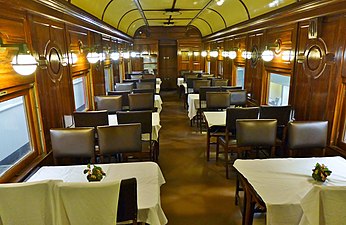Catch Point (periodical)
History

Mile End, 1964–1988
In 1963, a group of rail preservationists asked the South Australian Railways Commissioner to allocate land near the site of the former Mile End locomotive depot to hold a small collection of withdrawn steam locomotives. The first locomotive arrived in 1964 and in 1970 the site opened as the Mile End Railway Museum. Only a few exhibits were under cover and the effects of weather took their toll; an alternative, under-cover venue was sought.
Move to Port Adelaide
In 1987, the Mile End Railway Museum obtained a $2 million Bicentennial commemorative grant to redevelop the former Port Dock goods terminal, off Lipson Street, as the new property. In January 1988, the museum closed at Mile End and 11 months later opened as the Port Dock Station Railway Museum.
In 1999, funding was received as part of Australia's Centenary of Federation to construct a Commonwealth Railway Museum within the museum's precinct. The facility, opened in 2001, houses a representative sample of exhibits from the Commonwealth Railways and its successor, the Australian National Railways Commission. Included are vehicles from The Ghan, Tea and Sugar and Trans-Australian trains. At the opening, the museum was renamed the National Railway Museum on the initiative of deputy prime minister and noted railway enthusiast, Tim Fischer, AC.
In May 2009, the main pavilion was named after Ron Fitch, who as South Australian Railways Commissioner had facilitated the transfer of much of the museum's early rolling stock. At the same time, the Commonwealth Railways Museum was renamed the Ronald E. Fluck Pavilion, after the museum's founder.
Construction of spur line
In 2017, $16.4 million was allocated in the state budget for a new station to be built near the original site of the Port Dock railway station, at the end of a new 1.0 km (1100 yard) spur line using the existing corridor beside the museum that connects to the Outer Harbor railway line. In June 2019, when some museum track had already been dismantled, the development was paused while a North West Planning Study was conducted; a forecast cost increase to $40 million was cited. On-ground preparatory work was reversed in January 2020.
In June 2023 the project, by then budgeted at $51 million, resumed with partial severing of the direct rail connection to suburban lines, followed by removal of some of the museum's rail siding storage space. A general loss of land in the museum's leaseholding was incurred. The line extension was planned to include a dual-purpose island platform for both regular suburban services and on the other side of the platform during special event days and holidays, broad-gauge heritage trains.
Collection

The museum houses its large static collection in two pavilions and the historic Port Dock railway station goods shed. On the site, all three mainline gauges of Australia are represented: narrow, 1067 mm (3 ft 6 in); standard, 1435 mm (4 ft 8+1⁄2 in); and broad 1600 mm (5 ft 3 in). The collection comprises more than 100 major exhibits, mainly from the Commonwealth Railways and South Australian Railways. It also holds rolling stock from the Silverton Tramway and Victorian Railways.
Operational locomotives and railcars on these gauges are:
- narrow gauge: former Broken Hill Associated Smelters steam locomotive Peronne (1918 Andrew Barclay 0-6-0T tank locomotive)
- broad gauge: former SAR diesel-electric locomotives 515 and 801, "Red Hen" railcars 321 and 400, and "Bluebird" railcar 257.
The museum also operates locomotives, including steam locomotives Bill (with a 2-4-0 wheel arrangement) and Bub (0-4-2 T), for visitor rides on its 457-millimetre (18.0-inch) track around the site.
Locomotive and railcar exhibits as of 2022
- Steam locomotives
- SAR Rx 93
- SAR Y 97
- SAR P 117
- SAR T 253
- SAR F 255
- SAR 409
- SAR 504 Tom Barr Smith
- SAR 523 Essington Lewis
- SAR 624
- SAR 702
- SAR (ex VR) 752
- CR G 1
- CR NM 34
- Silverton Tramway Y 12
- Silverton Tramway A 21
- Silverton Tramway W 25
- Broken Hill Associated Smelters Peronne ←(operational)
- BHP Whyalla no. 4
- Diesel locomotives
- SAR diesel shunter 515 & 517 ←(no. 515 is operational)
- SAR mainline diesel 703 ←(static, to be operational)
- SAR diesel shunter 801 ←(operational)
- SAR mainline diesel 900
- SAR mainline diesel 930
- CR GM class GM 2
- CR mainline diesel NSU 61
- CR diesel shunter DE 91
- Railcars
- SAR Model 55 Brill railcar 8
- SAR Model 75 Brill railcar 41
- SAR Bluebird railcar 257 Kestrel ←(operational)
- SAR Redhen railcars 321 and 400 ←(operational)
- STA 2000 class railcars 2006 and 2112
- CR Budd Railcar CB 1
Operations

The museum operates a number of historic locomotives for shunting of rolling stock and during special events. Within the museum grounds, 457 mm (18.0 in)-gauge steam and diesel locomotives provide rides on a track 1.2 km (0.75 mi) long. In 1992, the museum, in cooperation with the local council, built a 1.7 km (1.1 mi) line along the beach from Semaphore to Fort Glanville. From October to April, trains operate – subject to temperatures being less than 35 °C (95 °F) – on weekends, public holidays and school holidays. The line travels along the coastline, through the sand dunes and the Fort Glanville Conservation Park; the locomotive is turned at each end.
Since 1982 the museum has published its bi-monthly Catch Point Magazine, a full-colour, A5-format, 48-page magazine that features news and articles about railway operations mainly in South Australia.
Buildings
The museum has a number of historic buildings, some original to the site and others transported for display, including the following:
- Port Dock station goods shed: this is the only remaining intact building of the Port Adelaide (later named Port Dock) station complex. Typical of South Australian Railways structures of the 19th century, architecturally it is an austere industrial building notable for its scale and the use of large timber beams throughout. Its size and scale reflect the economic prosperity of South Australia when it was built, in 1878 – a time when Port Adelaide's facilities were being extended to serve the growing import and export trade. It has been entered in the SA Heritage Register.
- Woodville signal cabin: this two-storey wooden building from suburban Woodville, prominently backing on to Lipson Street, is connected to the narrow gauge yard.
- Callington shelter shed: typical of a type of building provided by the South Australian Railways at small country stations, this shelter shed and minuscule booking office was originally built in 1951 for the then small rural community of Callington, 24 kilometres (15 miles) west of Murray Bridge on the main Adelaide-Melbourne line.
- Eudunda gangers' shed: typical of hundreds of such sheds on the South Australian Railways where track-maintenance gangers and packers held their tools and track inspection trolleys, this example came from Eudunda, 110 kilometres (68 miles) north of Adelaide.
Gallery
-
A train on the museum's 1.7 km (1 mi) Semaphore and Fort Glanville Tourist Railway, headed by miniature steam locomotive, Bub
-
Turning a miniature locomotive on the seafront line at Semaphore
-
SAR-designed and built diesel-electric locomotive no. 900 ready for transfer to the museum
-
Commonwealth Railways dining car DA 52, which served fine food across the Nullarbor Plain between 1930 and the 1960s
-
Commonwealth Railways GM class diesel-electric locomotives, such as no. GM2, revolutionised schedules on the Trans-Australian Railway in 1951
-
Railway signalling and safeworking display
-
South Australian Railways 75-class railcars, designed by US company Brill, were introduced in 1928 to run on suburban and country lines alike
-
The relocated Woodville signal cabin
-
1914-built locomotive no. 4, which hauled BHP iron ore trains from Iron Knob to Whyalla
-
Narrow-gauge Beyer-Garratt 400 class locomotive no. 409 was one of ten introduced in 1952 to haul silver-lead-zinc ore mined at Broken Hill to Port Pirie
See also
Notes
- ^ The Australian National Railways Commission used the trading names, successively: Australian National Railways, Australian National, and AN (the latter being a trademark).
- ^ Mr Fischer proposed "national" in view of the multi-jurisdictional scope of the museum's collection and the incorporation of all three of the nation's major railway gauges.
References
- ^ "About the National Railway Museum – A brief history of the museum". National Railway Museum. Archived from the original on 14 February 2018. Retrieved 14 February 2018.
- ^ 150 years of the Port Adelaide Railway, 1856 to 2006: a review of the Adelaide to Port Adelaide Railway. Port Adelaide, S. Aust.: National Railway Museum. 2006. pp. 79, 80.
- ^ Sampson, Bob (November 2019). "Vale – Tim Fischer AC". Catch Point Magazine. Port Adelaide: National Railway Museum. p. 28.
- ^ "Port Adelaide to get new train station served by 1km rail spur". ABC News. 24 June 2017. Archived from the original on 24 June 2017. Retrieved 25 June 2017.
- ^ Kemp, Miles (24 June 2017). "State Budget 2017: Trains return to the heart of Port Adelaide after a 36-year absence". The Advertiser. Adelaide. Retrieved 15 July 2017.

subscription: the source is only accessible via a paid subscription ("paywall"). - ^ Pisani, Ashleigh (30 June 2017). "National Railway Museum warns issues to resolve before Port Dock Railway spur can return". Portside Messenger. Adelaide. Archived from the original on 7 October 2021. Retrieved 15 July 2017.
- ^ Pisani, Ashleigh (18 July 2018). "Barossa Wine Train booted from the Port". Portside Messenger. Adelaide. Retrieved 1 August 2018.
- ^ Adelaide's public transport going back to the future under Stephan Knoll Archived 12 April 2021 at the Wayback Machine ABC News, 21 June 2019. Retrieved 21 June 2019.
- ^ Sampson, Bob (July 2019). "DPTI News". Catch Point Magazine. Port Adelaide: National Railway Museum. p. 6.
- ^ Sampson, Bob (July 2023). "Dept Infrastructure & Transport news". Catch Point Magazine. Port Adelaide: National Railway Museum. p. 5. ISSN 2207-9114.
- ^ "Search rollingstock exhibits". National Railway Museum. Archived from the original on 3 April 2013.
- ^ "Catch Point Magazine". National Railway Museum. Retrieved 23 October 2023.
- ^ Australian Railway Historical Society. South Australian Division; Mile End Railway Museum; Port Dock Station Railway Museum (1982), Catchpoint : S.A.'s modern railway magazine, Mile End Railway Museum (South Australia)
- ^ National Railway Museum (2017), Catch Point Magazine (digital), National Railway Museum, ISSN 2207-9114
- ^ "Buildings". National Railway Museum. Archived from the original on 3 April 2013.
- ^ "The South Australia Heritage Places database". maps.sa.gov.au. Archived from the original on 18 May 2019. Retrieved 18 May 2019.
Bibliography
- Sampson, Bob (2010). Your Guide to the National Railway Museum (6th (revised) ed.). Port Adelaide, SA: National Railway Museum.









